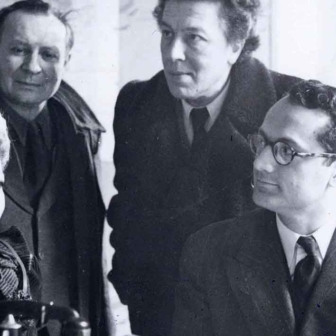On Wednesday this week the Triumphal Arch of Palmyra was installed in the National Mall in Washington in the presence of various luminaries. Well, not the arch itself, which lies in ruins on the Syrian steppe, but a reconstruction that’s being trundled around major cities to advance the cause of protecting world monuments from the depredations of war.
The initiative is the work of the self-styled Institute for Digital Archaeology, which promotes the arch as “an international symbol of resistance to extremist groups who seek to obliterate world history and heritage in favour of their own social, religious and cultural narratives.” Which immediately raises the question: is this costly and cumbersome gesture the best way to contribute to the eventual reconstruction of Syria’s ancient monuments?
The reconstructed arch’s first brush with fame came in April 2016 when it was unveiled in Trafalgar Square by no less a self-obsessed luminary than Boris Johnson, who was mayor of London at the time. The Financial Times put the cost of the initial exercise at £2.5 million (around A$4.5 million). For that sum, all the organisers got was a single-opening arch reproduced at one-third the scale of the original.
But the scaling down wasn’t the only shortcut involved in “reproducing” an arch that served as a focal point along Palmyra’s magnificent 1.2 kilometre colonnaded central street. The original arch was not a two-dimensional, single-opening facade, and certainly not a standalone “triumphal arch,” as proclaimed by the Institute for Digital Archaeology. Originally flanked by side passages opening through separate arches, the edge-shaped structure was designed to disguise a fifteen-degree bend in the great colonnaded axis. It was perhaps the most ingenious solution the Roman Empire ever devised to correct an embarrassing civic planning snafu.
Through most of the second century AD, work proceeded slowly on the axis the city had commissioned as the civic feature that most sizeable cities of the eastern regions of the Empire believed they needed. Decades later, with the project approaching the central zone — there to be lined with the most important honorific statues — its planners realised that it would, if not corrected, slice off a large part of the courtyard of the temple of one of Palmyra’s favourite deities, the Arab god Nabu. The solution was to bend its course while disguising the interruption in the majestic rows of columns by devising an arch, each of whose facades were angled according to the section of the road they faced.
Having decided that a scaled-down, trimmed and truncated arch was all they could manage, the arch’s modern proponents fed hundreds of pasted-together pre-conflict tourist snaps into a machine that produces 3D reconstructions. The arch would be reproduced in marble, ignoring the fact that the original was worked, like virtually all of Palmyra’s buildings, in the beautifully subtle honey-coloured limestone of the local Palmyrene quarries. (Marble is not found in Syria.) Extraordinarily, the builders opted for the prestigious stone from the Carrera area of Italy, the material of choice for ostentatious benchtops around the world. As the Carrera stone lacked the quiet subtlety of the Palmyra limestone, it was decided to dye it, though even then the digitally driven carving rather blurred the fine detail of the original, making it look like it had been made out of plasticine.
Islamic State, whose contribution to the destruction of many of Syria’s ancient or Islamic monuments, including the arch, received saturation media coverage, is now largely driven out of Syria. Its destructive path in Palmyra was one of the most notable acts of mindless destruction in the Syrian conflict — though it barely reached the benchmark already established in 2014 by the nihilism of Islamic Front, an al Qaeda offshoot, whose tunnel bombing in Aleppo sucked numerous Islamic monuments into deep moon-like craters.
It is remarkable that outsiders have not focused on how this group received its funding and shipped in the explosives needed for its six-month campaign of destruction across the historic centre of Aleppo. (The answer would need to be sought in the deep pockets of various Gulf interest groups anxious to advance the cause of Wahabi interpretations of Islam.) Islamic Front, of course, had a less slick propaganda arm to advertise its exploits, and by late 2014 the carnage visited on eastern Aleppo’s population was rightly attracting most media attention.
Well-meaning efforts to keep alive concerns about the fate of Syria’s monuments are not to be scorned, of course. But it seems right to raise questions about whether now is the time to spend large sums outside Syria for exercises such as the Palmyra Arch campaign. Reconstruction should be done only when the conditions for reconstruction are right, and should be part of a program that involves the regeneration of Syria’s devastated cities as a whole.
Reconstructions can aid in the creation of employment and use the skills that Syrians have applied over many decades in caring for and restoring their heritage. Before 2011, Syria still had access to most of the quarries that provided the ancient stone. All modern buildings in the centre of its major cities are required by law, for prestige reasons, to use stone for their facades, thus preserving the skilled labour force of centuries that in most other countries around the world is only an exotic throwback.
Decisions on reconstruction in Syria are held up by the sanctions against the Assad government. This shouldn’t mean that Western organisations resort to merely hand-wringing, though, or unnecessarily expensive exercises like the Palmyra reproduction, which risks discouraging interest in the real thing by removing it from its context, and seems a dubious use of funds in any case. It would be better to put the resources aside until reconstruction can be launched as part of a program to assist, even in a modest way, in Syria’s rebuilding. •




